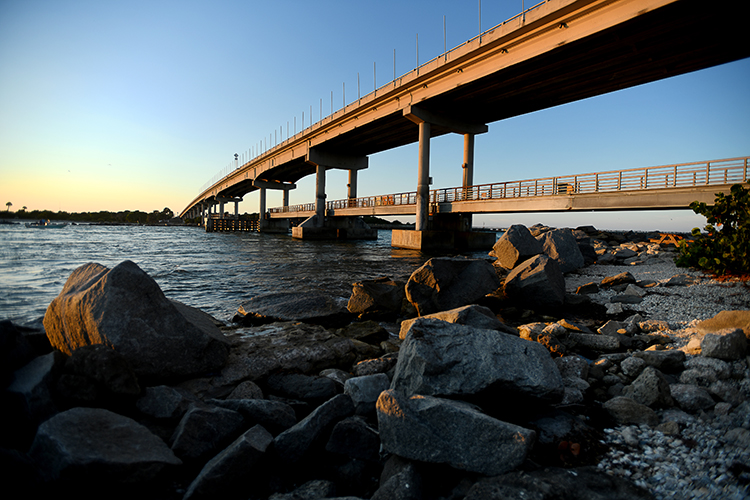
Construction on the repair or replacement of the Sebastian Inlet bridge is tentatively set to begin in the winter of 2026, but exactly what the multimillion-dollar project will entail is not yet known.
Officially named the James H. Pruitt Memorial Bridge, the heavily traveled 2-lane, 1,548-foot-long bridge is historically significant as the first bridge to span the often turbulent tidal waters of the Sebastian Inlet where the Indian River Lagoon and the Atlantic Ocean interconnect.
Built in 1964 to connect A1A from Brevard to Indian River County, bridge opened Feb. 27, 1965 with great fanfare, complete with a military aircraft fly-over during the official ceremony.
According to FDOT, the 57-year-old structure is eligible for the National Register of Historic Places.
But the historic bridge has no accommodation for bicyclists or pedestrians, and the purpose of the rehab or replacement is to “address the gap in system linkage for bicyclists and pedestrians,” as well as to address “the structural and functional deficiencies” of the steeply arched structure.
The bridge underwent repair work in 1978 and 2003, but following Hurricane Florence in 2018, the span was rated “structurally deficient,” with a health index of 79.8.
This does not mean the bridge is unsafe to use, but according to FDOT Bridge Policy, bridges with a health index of less than 85 require repairs or replacement.
Whether the bridge will be repaired and upgraded or replaced will be determined by the outcome of an ongoing development and environmental study, according to FDOT.
Begun late last year and scheduled to conclude in mid-2023, the FDOT study covers the 1.108-mile stretch of State Road A1A from the Sebastian Inlet State Park’s north boundary in Brevard County across the inlet to the park’s south boundary in Indian River County.
During a Florida Department of Transportation online workshop, Project Manager Binod Basnet, and consulting Project Manager Beth Beam of Stantec, an international design and consulting firm, discussed the project’s preliminary timeline and the broad scope of the lengthy study. Design work is set to begin in 2022 and be complete by 2025. During that time, any necessary right-of-way acquisition would be accomplished.
The study will explore the “social, cultural and environmental” impacts of the project and engineering alternatives to ensure compliance with federal and state laws, and funding requirements.
Many of the questions during the public input segment of the workshop focused on accommodations for bikers, specifically the width of the bike lanes.
Another question concerned sailboat mast limits. The FDOT will communicate with the Coast Guard regarding navigation and vertical clearance issues. “There may be times [during construction],” Beam said, “when the inlet may be closed to navigation.”
Other people asked whether the bridge would be closed to vehicular traffic at any time during construction, leaving no way to cross the inlet.
Stopping just short of an unequivocal ‘No,’ Beam gave repeated assurances that structural engineers “will evaluate the constructability of alternatives that would keep the bridge open during construction. We know how important the bridge is to first responders, to all travel.”
Chartered in 1919 to maintain the navigational channel between the Atlantic Ocean and the Indian River, the Sebastian Inlet District is a major stakeholder in the bridge project.
Beth Mitchell, who has held the Indian River County seat on the District Commission since 2004, said “I’d love to see the design take into consideration pedestrian and bicycle traffic.
“It is one of the most scenic spots [along Highway A1A]. It would make sense.”



